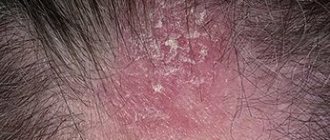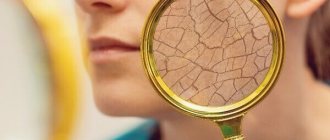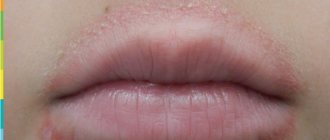Other diseases starting with the letter “D”: Dacryocystitis, Farsightedness, Color blindness, DIC, Bicornuate uterus, Dementia, Allergic dermatitis, Depression, Atopic dermatitis, Perioral dermatitis, Dermatitis, Diabetic neuropathy, Diabetic retinopathy, Diabetic foot, Diarrhea, Diathesis, Diverticulosis colon, Dermatophilia. Diaper dermatitis. Contact dermatitis.
People susceptible to allergic diseases may notice scaly rashes around the mouth. This disease has a medical name - rosacea-like or perioral dermatitis. Peeling of the eyelids and skin around the eyes (periorbital) is more rare.
Causes of the disease
Perioral dermatitis may appear for the following reasons:
- use of low-quality cosmetics on the face;
- the presence of infectious diseases in chronic or acute form;
- use of ointments with corticosteroids;
- hormonal imbalances caused by various reasons;
- disturbances in the functioning of the gastrointestinal tract;
- toothpastes containing fluoride.
How to remove acne* on the chin: using Clindovit® gel
Acne is a chronic disease that cannot be completely cured. The risk of relapse always remains [18]. For mild to moderate acne, Clindovit® gel can be used [6, 18]. It contains clindamycin phosphate [6]. It is an antibiotic that exhibits antimicrobial activity against propionibacteria [6]. Also, after applying Clindovit® gel to the skin, the level of free fatty acids decreases from approximately 14% to 2% [6]. The drug must be used regularly, applied to the skin 2-3 times a day [6].
*acne
Treatment methods
The method of treatment for perioral dermatitis is determined by the attending physician. The duration of treatment may take a calendar month.
Basic recommendations for treatment methods:
- temporary but complete refusal to use cosmetics on the face;
- exclude the use of ointments containing corticosteroids;
- additional moisturizing of the facial skin is required;
- in sunny weather, you should protect your skin from exposure to ultraviolet rays as much as possible;
- try to eat foods containing hot and salty seasonings as little as possible;
- a doctor may prescribe electrolysis of diseased skin areas;
- in some cases, the patient is sent for cryomassage using liquid nitrogen;
- Antibiotics or medications from the imidazole group may be prescribed;
- the patient should start taking vitamins B6, niacin and riboflavin.
In some cases, observation at a dispensary may be required.
Ointments and creams for dermatitis
Creams or ointments for dermatitis have slightly different compositions. Thus, the ointment is made on a fat basis, which can be used as vegetable or mineral oils or animal fats. Such products have a dense, slightly viscous structure. They are not immediately absorbed into the skin, but penetrate into its deeper layers. Ointments are not recommended for treating wet surfaces. They are much more effective against dry rashes and chronic inflammation.
Creams have a different base - hydrophilic. Thanks to this, they have a lighter structure, are well absorbed and do not leave greasy marks on the skin. The creams are suitable for the treatment of moderately weeping rashes; they are used for acute inflammation, for lesions of the facial skin and areas with a large number of sebaceous glands, where the use of oily products is undesirable.
Let's consider several options for dermatitis remedies used in medical practice:
- hormonal ointments with pronounced antiallergic and anti-inflammatory effects, which include topical corticosteroids;
- non-hormonal topical agents that have anti-inflammatory and antibacterial effects, relieve itching and promote wound healing.
Non-hormonal drugs
Non-hormonal creams do not contain corticosteroids. The composition may be based primarily on plant components, or not contain them at all. These medications do not act quickly. Their main advantage is the possibility of using them for a long time, including in children. Among non-hormonal creams and ointments there are products with antiseptic, anti-inflammatory, moisturizing, and regenerating effects.
Hormonal drugs
Hormonal ointments and creams in the treatment of dermatitis are considered more effective than non-hormonal ones. The drugs can contain either one active component (topical glucocorticosteroid) or have a complex effect due to the presence of an antibiotic and an antifungal agent in the composition. The use of combined drugs is advisable in case of a complicated course of the disease, when a secondary bacterial or fungal infection is added to the inflammation.
Treatment of atopic dermatitis
To achieve maximum effectiveness from therapy, it is recommended to follow an integrated approach:
- identify and, if possible, eliminate the factors causing atopic dermatitis;
- drug therapy with local agents, selected depending on the severity and form of inflammation;
- proper skin care using moisturizers and softening agents (emollients).[4]
Akriderm preparations are products for the local treatment of manifestations of atopic dermatitis with a wide spectrum of action, produced in the form of cream and ointment of 15 g and 30 g. Depending on the severity, localization, form and course of the disease, the drug is selected:
- with one active ingredient – Akriderm® ointment and cream;
- combined preparations “hormone + antibiotic” - ointments and creams Akriderm GENTA;
- combined preparations “hormone + antibiotic + antimicrobial component” - ointments and creams Akriderm GK.
The modern drug Akriderm GK is a potent drug[5] and has 4 effects at once:
- anti-inflammatory;
- antiallergic;
- antibacterial;
- antifungal. [6]
Treatment of seborrheic dermatitis
The cause of seborrheic dermatitis is infection of the skin by the yeast-like fungus Malassezia. For its treatment, external antimycotics or antifungal drugs are prescribed. Akriderm SK ointment contains betamethasone and salicylic acid. The drug has anti-inflammatory, anti-allergic, anti-exudative, anti-edematous and antipruritic effects, inhibits the accumulation of leukocytes, inhibits phagocytosis, reduces vascular tissue permeability, and prevents the formation of inflammatory edema. As a result of use, the microflora of the skin is restored, scales are exfoliated and sebum production is normalized.[7]
Treatment of allergic dermatitis
To successfully treat allergic dermatitis, it is first necessary to determine the allergen that provoked the disease and partially or even completely eliminate the provoking substance. In the acute period, a specialist may prescribe the use of compresses with cold water and tanning decoctions, which are applied every 3-4 hours for 15 minutes. This helps reduce skin weeping. Drug treatment involves the use of topical glucocorticosteroids in the form of ointments and creams, which are selected depending on the form and severity of inflammation.[8]
If allergic dermatitis is complicated by a microbial infection, it is recommended to use combined external medications, such as Akriderm GK, which, in addition to GCS, contain an antibiotic (gentamicin) and an antifungal component (clotrimazole).
Remember that treatment of dermatitis and selection of medications is carried out only by a specialist dermatologist after a preliminary consultation and examination of the patient.
Preventive measures
The key preventive measures to prevent the development of perioral dermatitis are:
- protection of facial skin from exposure to sunlight;
- maintaining proper nutrition with minimal consumption of hot and salty seasonings;
- minimizing skin dryness;
- use high-quality cosmetics from trusted manufacturers.
Although perioral dermatitis does not pose a health threat, treatment is necessary.
Clinical manifestations
Localization : has a characteristic location of the rashes, these are the perioral zone, nasolabial folds, skin of the chin and cheeks. The affected areas are characterized by symmetry.
Characteristic sign : a strip of healthy skin around the lips measuring 2-4 mm (characteristic in most cases, however, the case shown in the photo is a rare exception).
Rashes : pinkish-red papules, papulo-vesicles and papulo-pustules measuring 1-2 mm are located on an erythematous (red) background. Rashes are resolved by the appearance of crusts in place of the papules. The skin is dry, swollen.
Subjective sensations: characterized by a feeling of skin tightness, itching and burning.
Outbreaks of erythema with temperature changes, alcohol intake, spicy and hot foods. These manifestations are also characteristic of rosacea, which complicates the diagnosis of perioral dermatitis.
pigmentation may develop .
Diagnostic features
Before talking about therapy, the doctor will definitely give a referral for examination of the child. The purpose of diagnosis is to confirm the presence of an allergy and determine the substance that provoked such a reaction. The examination will consist of the following stages:
- taking an anamnesis - the doctor must find out what potential allergens the child has been in contact with recently, he is also interested in whether there are any allergies in the baby's family - in this case, the tendency to allergies will be quite high;
- laboratory blood tests, their task is to determine the level of immunoglobulin E. This protein is responsible for the development of an allergic reaction and its intensity;
- allergy tests - they allow you to determine which substance caused the child’s allergy, and accordingly, increase the effectiveness of further treatment.
Once the diagnosis is complete, treatment will be prescribed. It is usually represented by a comprehensive program with high results.
Carrying out diagnostics
Before starting therapeutic measures, the doctor collects anamnesis from the patient in order to determine the cause of the development of the allergy, its nature and intensity of symptoms. It is mandatory to determine a person’s genetic predisposition to allergic manifestations.
After collecting an anamnesis, a laboratory examination is prescribed, including a blood test to determine immunoglobulin levels. It is this indicator that is responsible for the intensity of the development of the allergic reaction.
If necessary, allergy testing is recommended. With their help, you can find out exactly what substance is causing your skin to itch. It must be borne in mind that skin tests can only be performed on a child under the supervision of the attending physician, since in children the immune reaction can be completely unexpected.
After completing the necessary examination, a comprehensive treatment is prescribed, which has the necessary effectiveness and leads to a positive result.
Diagnostics
When the first symptoms occur, you must contact a medical facility.
You will need to consult a therapist (pediatrician), dermatologist and allergist. Diagnostic measures
| Study | What does it show | Indications |
| General blood analysis | Number of basophils and eosinophils, hemoglobin level | Harmless methods, since there is no direct contact with the allergen. Blood testing is carried out after it is collected in a laboratory. |
| Determination of total Ig E | Total Ig E content | |
| Detection of specific Ig E | Reaction to used allergens | |
| Scraping the affected area | Eliminates dermatological problems | |
| Allergy tests | Detects allergen | It is not recommended for children under three years of age, as there is direct contact with the allergen. Their skin is too sensitive and can give false positive responses. Cannot be used after anaphylaxis. |
Allergy tests
| Type of test | Method of implementation |
| Applique | The strips soaked in allergens are fixed on the skin for two days, after which the result is assessed. They cannot be removed or wet. |
| Scarification | Drops of the allergen are applied to the dermis and scratches are made with a scarifier, an assessment is given after 20 minutes |
| Prick test | Allergen concentrates are applied to the skin and punctures are made with a lancet, the result is assessed after 20 minutes |
| Provocative | Irritants are applied under the epidermis, to the mucous membranes of the nose, eyes, mouth using drops or spray, inhalation |
The provocative method is extremely dangerous due to the possibility of developing an immediate acute reaction up to anaphylactic shock, therefore it is not performed for children, and also for adults in case of some diseases. Used in rare severe cases or if other methods have not given the desired result.











